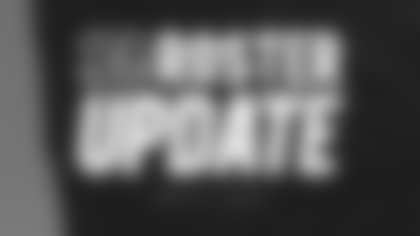Running back Giovani Bernard is the latest second-round gem for the Bengals.
Maybe Bengals fans shouldn't be so jacked about that first round of the NFL Draft on May 8. Just maybe it's that amazing second round on May 9 that should hold their attention.
Count with me now. The franchise's all-time leading rushing, Corey Dillon. The franchise's all-time leading receiver, Chad Johnson. The Bengals last NFL MVP, quarterback Boomer Esiason. The only quarterback to lead the Bengals to three straight playoffs, Andy Dalton.
Second-rounders, all.
Of the Bengals' 46 Pro Bowlers, 13 have come out of the second round, nine from the first.
So maybe Bengaldom shouldn't be studying the five cornerbacks that have been mocked to the Bengals by various sources at No. 24 in the first round. Or Missouri defensive end Kony Ealy (the latest Bengals.com Media Mock choice), or Ohio State linebacker Ryan Shazier, the hometown favorite.
(It seems like the only cornerback that hasn't been mocked to the Bengals is Dick LeBeau.)
Maybe we should be looking at Virginia tackle Morgan Moses or Pittsburgh defensive tackle Aaron Donald, mocked to the Bengals early on in the process with the 55th pick by NFLDraftScout.com and draftsite.com, respectively. On Wednesday, draftsite.com had updated it to Tennessee tackle JaWuan James. Wednesday's update on WalterFootball.com projects USC center Marcus Martin.
Certainly not as exciting as some of the recent Bengals' second-rounders, such as Florida defensive end Carlos Dunlap at No. 54 in 2010 and North Carolina running back Giovani Bernard at No. 37 last year. Averaging half a sack in his first 54 NFL games, Dunlap pulled down a $40 million extension while Bernard bid for NFL Rookie of the Year with a club record 56 catches by a running back.
And then there's left tackle Andrew Whitworth with that same 55th pick in 2006. A versatile player who has become a Pro Bowler at left tackle, Whitworth's biggest contribution may be helping change the culture in the locker room.
But the second-round success hasn't been confined to this century. It started in the second year of the franchise when Pro Bowl linebacker Bill Bergey arrived from Arkansas State in 1969. It continued with three-time Pro Bowl safety Tommy Casanova out of LSU in 1972 and 20 years later Carl Pickens went on to briefly become the club's all-time leading receiver as a second-rounder out of Tennessee. In between, Florida wide receiver Cris Collinsworth went to the first three Pro Bowls of his career after falling to the second round when Bengals founder Paul Brown allegedly took him off the board in the first when he double checked his skinny frame.
Even those second-rounders that didn't hang around long had a huge impact. Before he ripped up his knee, Tulane's Eric Thomas became the Bengals' first Pro Bowl cornerback since Lemar Parrish. Before he broke his leg in the 2000 training camp, San Diego State's Darnay Scott became one of their biggest down-field threats ever with 15.7 yards per catch and is still fifth on their all-time per list with a minimum of 100 catches.
Why the overflowing riches in Round Two? There are no easy answers when you start asking the people who made those selections. But one of those guys selected has an idea.
"I've always thought they had to draft numbers in the first round, then in the second round they just got down to drafting football players," says Collinsworth, who now has almost as many Emmys broadcasting the NFL (14) as career yards per catch (16).
"You don't want to look like a fool not drafting somebody that runs 4.35, or someone that is 6-4," Collinsworth says. "The numbers come out in the first round. In the second round, there are flaws of some kind, but you see on tape they can play the game of football and a lot of times they end up being good players for you."
The Bengals have certainly lived that. At least three Bengals we know of down through history were discussed as possible selections in the first round and were there to be taken in the second: Collinsworth himself, Dillon, and USC middle linebacker Rey Maualuga. Dillon and Maualuga had off-field questions, which is why Dunlap, another first-round talent plucked in the second, was there at 54.
Some of it is willing to take a risk with the off-field stuff, but the Bengals don't do that nearly as often now, particularly in the draft. For instance, it's hard to see after the last five drafts the Bengals taking troubled Georgia middle linebacker Odell Thurman in the second round like they did in 2005.
But there is also just as much risk on the field.
Dalton isn't built like a prototypical pro QB. Esiason threw it all around the yard. Was Whitworth athletic enough to play NFL tackle? (He was.) The 5-9 Bernard emerged just as running back value was taking a major hit in the era of the spread.
"There is their draft value and there is their playing value,' says one NFL scout. "It's not necessarily the same thing and you have to be aware of both of them. You have to be aware of who you can get when. You may like a guy, but if you think you can get him later and get something else, you do it."
Asked what his flaws were, Collinsworth laughs and says, "Too skinny, too slow, too ugly," but he could have stopped at "Too skinny."
Some believe the second-round phenomenon is built on the infatuation with the first round.
"Everyone is focused on that first-round flop," says another NFL scout. "But the second-round flop hurts you just about as badly. Those guys have to be players and they have to be good players."
Exhibit A is the Bengals' recent success in the second round compared to the rest of the AFC North. Take a look at the breakdown of second-round picks in the division in the last five drafts and in parenthesis we'll put their approximate career value as assigned by pro football reference.com:
BENGALS: 2009: MLB Rey Maualuga (33); 2010: DE Carlos Dunlap (18); 2011: QB Andy Dalton (36); 2012: DT Devon Still (2); 2013: RB Giovani Bernard (9), DE Margus Hunt (1).
STEELERS: 2009: None; 2010: OLB Jason Worilds (15); 2011: OT Marcus Gilbert (15); 2012; OT Mike Adams (8); 2013; RB Le'Veon Bell (8)
RAVENS: 2009: DE Paul Kruger (14); 2010: LB Sergio Kindle (0), DT Terrence Cody (12); 2011; WR Torrey Smith (23); 2012: OLB Courtney Upshaw (12), G Kelechi Osemele (10); 2013: OLB Arthur Brown (1).
BROWNS: 2009: WR Mohamed Massaquoi (13); WR Brian Robiskie (3); DE David Veikune (1); 2010: S T.J. Ward (25), RB Montario Hardesty (4); 2011: DE Jabaal Sheard (22), WR Greg Little (12); 2012: WR Josh Gordon (17) (supplemental), OT Mitchell Schwartz (12); 2013: None
The numbers clearly give it to the Bengals. They make sense for Dalton and Ward, the lone two Pro Bowlers picked in the second round in the AFC North since '09. Only Ward, Ravens wide receiver Torrey Smith, and Browns defensive end Jabaal Sheard are rated higher than the third Bengal, Dunlap, and we know that these numbers can be disputed, debated, whatever.
But they do give a glimpse why the Steelers have had trouble protecting their quarterback when you compare Whitworth's value of 51 and Bengals right tackle Andre Smith's 26.
It also gives you an idea why the Ravens defense wasn't able to stave off time any longer last season and look how a second-round wipeout can hurt you.
(The Bengals weren't wiped out in the 2004 second, but cornerback Keiwan Ratliff and safety Madieu Williams weren't long-term answers. So safety never really got figured out until veterans Chris Crocker and Reggie Nelson started arriving and they realized they had to solve corner in the first round and they did back to back with Johnathan Joseph and Leon Hall in 2006 and 2007.)
The Browns had three shots at the second round in '09 and none are still with the team. Josh Gordon rescued them with that supplemental pick. But have those receivers (like the hot-and-cold Little) struggled because of the lack of a consistent quarterback?
"You'd have to give it to the Bengals because of Dalton and Bernard," one of the scouts says. "Pittsburgh probably helped themselves the least and Baltimore had a very good pick with Torrey Smith, but they've got some guys there that they're waiting on."
And guys like Upshaw and Brown may end up coming through for that defense. But at the moment, the second round is holding up for the Bengals, just like it has since the '60s.
"For the last few years the league has had drafts with good quality depth with the exception of a very few guys," one of the scouts says. "In some of these there's not a great difference in the level of talent between the middle of the first round and top of the third. That's what each team has to judge. At what point in the first round do the first-round players run out?"
For the Bengals, more often than not, it seems like they don't run out until the second.















